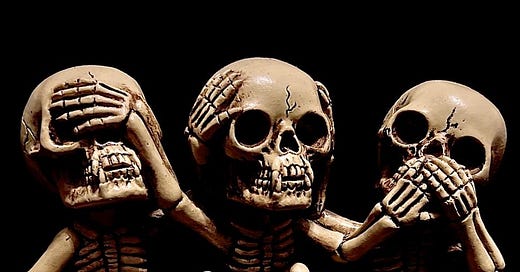The Irony of Skeletal Silence: A Philosophical Reflection
Brian Sankarsingh ponders seeing no evil, hearing no evil and speaking no evil
TO OUR LOYAL READERS: Hi everyone, it’s Brian here. Before we dive into today’s article, I’d like to ask for a small favour. This year, we're aiming to grow our community of readers. We're proud to be in the top 1% of Substack publishers for consistent content — which means you can count on us for a steady stream of engaging, thought-provoking articles, all completely free.
We don’t charge for subscriptions, but if you enjoy what you read here, please consider sharing our Substack with a friend or colleague. It’s a simple way to support our work and help us reach more curious minds.
Thanks so much! Now, here’s today’s article
Last year I went to Vegas with my very dear friend to celebrate his 60th birthday. Whilst there, I became enamoured with a sculpture of three skeletons parodying the old motif of three monkeys - see no evil, hear no evil, speak no evil. My wife demanded I buy the thing instead of just saying how much I loved it every time we went past it.
There was something otherworldly about this piece. It kept nagging at me, so now almost a year later this article and poem finally gave voice to the tug this had on my psyche. I hope you take something away from them both.
The proverbial trio of monkeys—seeing no evil, hearing no evil, and speaking no evil—has long served as a moral allegory, urging restraint in perception and communication. Yet when this motif is transposed onto human skeletons, the symbolism acquires a darker, more ironic resonance. Skeletons, stripped of flesh and sensory organs, become involuntary participants in this ethical injunction, embodying not just moral choice but the inevitability of death’s silence.
The traditional monkeys suggest volition; their covered eyes, ears, and mouth imply active refusal, a conscious turning away from corruption. But skeletons, already devoid of the capacity to see, hear, or speak, parody the very idea of moral agency. They are not avoiding evil—they are anatomically incapable of engaging with it. Here lies the irony: the skeletons literalize the maxim to the point of absurdity. What was meant as a call to virtuous restraint becomes a memento mori, a reminder that death enforces its own absolute silence.
Moreover, the use of skeletons subverts the original message’s intent. The monkeys’ gesture is pedagogical, a lesson for the living. The skeletons, however, belong to the dead, rendering the admonition futile. Can the dead be held accountable for what they no longer perceive or utter? The sculpture thus becomes a meditation on the limits of human morality—how our ethical frameworks dissolve when confronted with the neutrality of decay.
In this inversion, the artwork critiques the idealism of the original symbol. The monkeys assume living beings can choose ignorance, but the skeletons reveal the passivity underlying all existence. Evil persists not because we turn away, but because, like bones in the ground, we are ultimately powerless to confront it at all. The sculpture, then, is not just a warning—it is an epitaph for moral ambition itself.
Bones entwined in hollow pose One cannot see, one cannot hear The last has neither tongue nor voice They mock the maxim carved in stone The monkeys’ they can turn aside But fleshless things have none to make No evil blooms behind shut eyes No whispers haunt a deafened skull No slander parts the lipless grin What moral clings to vacant ribs What lesson stirs in sockets dark The dead need no philosophy They do not choose their blindness None can escape this quiet state Where neither sin nor virtue breathes Ours is the guilt of living still Of shielding sight and stifling speech While bones, indifferent, laugh beneath
Bio: BRIAN SANKARSINGH is a two-time award-winning poet and author. He is a Trinidadian-born Canadian immigrant who has published several books of poetry on a wide range of social and historical themes including racism, colonialism, and enslavement. Sankarsingh artfully blends prose and poetry into his storytelling creating an eclectic mix with both genres. This unique approach is sure to provide something for everyone.
Thanks for reading Seeking Veritas by The Professor, The Poet & Friends! Subscribe for free to receive new posts and support my work.






Hey Brian! I just finished reading, and I find this piece to be a stunning reminder that life is the only time we get to choose how we engage with good and evil.
The skeletons aren’t just creepy—they’re a wake-up call. We’re the ones who can act, speak out, and bring meaning to all of this. So if we’re here and breathing, the moral burden (and privilege) is still ours.
BTW! I'm currently writing this from Tobago. Great piece, thanks for sharing.😊💯